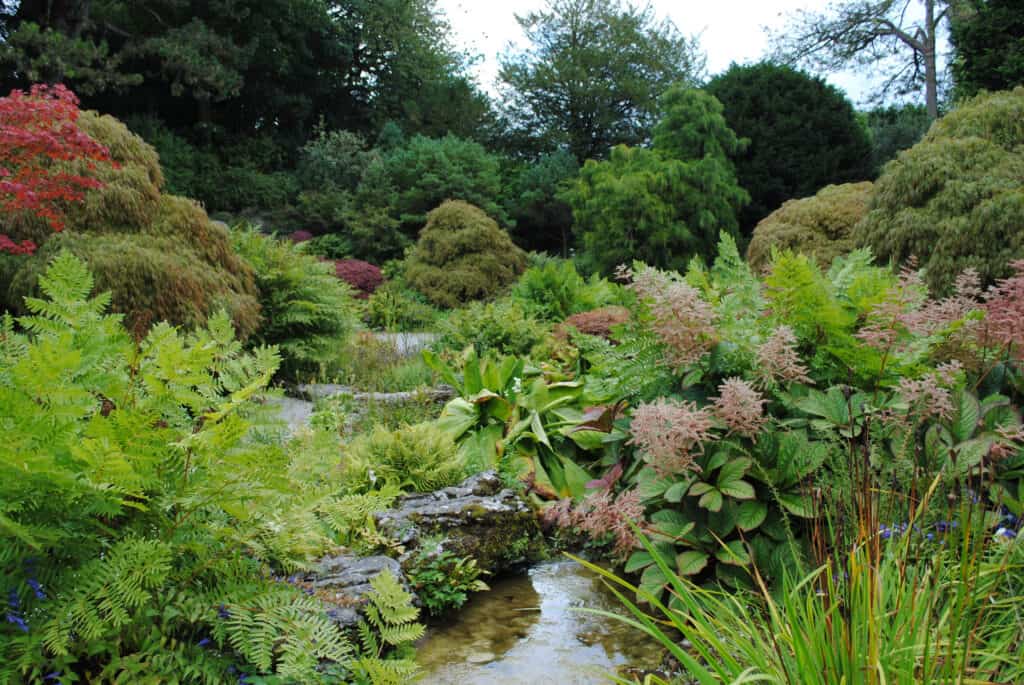It’s almost spring, when a homeowner’s fancy lightly turns to thoughts of landscaping and gardening. If that’s where your mind has been venturing lately, you’re not alone. And if you’re in the mood for something new and different than the same old look your home’s exterior has sported for years, why not consider getting trendy this year? Here are five emerging landscape design trends for 2023 that’ll spruce up your home beautifully.

Dump the Lawn Entirely
We know what you’re thinking — but take a deep breath. Yes, you’re absolutely allowed to eschew the glossy emerald expanse of a perfectly maintained lawn altogether. In fact, doing so will save water, trim maintenance expenses, and reduce or eliminate entirely your reliance on harmful pesticides and herbicides.
Swap out your high-maintenance grass for plants that are friendly to pollinators and much easier to care for, or create a lovely, wild meadow instead. Or build yourself a soothing rock garden, or even turn the entire yard into a food- and herb-producing garden.
You’ll want to check to make sure your plans are permissible under your local ordinances. Otherwise, the beauty of a lawnless yard is that there really aren’t any strict rules. You can create the look that’s right for your needs and lifestyle while helping the environment at the same time. That’s a trend we can get behind!
Going Local With Indigenous Plants
Avoid the merry-go-round of slavishly adopting generic gardening trends from national publications and embrace the indigenous bounty of our local region. Choosing indigenous plants helps ensure vibrant growth cycles, healthy plants, and less reliance on chemicals.
From trees such as gray birch, American beech, flowering dogwood, and Atlantic white cedar, to plants such as purple coneflower, black-eyed Susans, lady fern, and blue flag iris, this area is home to any number of vibrant plants that will thrive in local soil. Consider getting your soil tested and checking with your local cooperative extension office to make sure you’re choosing a good mix of indigenous plants that work with your home’s access to moisture and shade, as well as its soil type and pH.

Reuse and Recycle Landscape Materials
If you’re eco-conscious but not quite ready to eliminate the lawn completely just yet, try looking for landscaping materials and ideas from unusual sources. Repurposed building materials such as old bricks or reclaimed wood can provide imaginative, aesthetically pleasing borders and walkways for your landscape design.To get started, start digitally with a simple Google search for reclaimed landscaping materials near you. In addition to lumber yards and reclaimed wood suppliers, anything from nurseries to contractors can be a valuable resource. You may prefer to consult with a professional landscaper, however, since they’ll have existing connections and sources that might not be open to individual purchasers.
Bring the Outdoors In
Call it interiorscaping, or just bringing a bit of nature inside. Whatever you label it, staging your interiors with some healthy green houseplants, potted trees, and even interior courtyards will help you enjoy the lushness of nature all year long. You can adopt this trend in a number of ways:
• Add hardy plants to your entryway to help greet guests and residents, while providing a transitional space between the outside world and the comforts of home.
• Consider adding a dedicated greenspace to a room with excellent lighting and exposure, such as a sunroom or sitting room with an exterior wall.
• Think vertically by creating plant arrangements with variations in height along a single wall. Use planters, plant stands, trellises, hanging baskets, and other containers to create that height differential.
• Expand your houseplant collection by adding more unusual varieties for more color, texture, and visual interest. Look for plants with larger leaves and unusual shapes.
Consult with a professional gardener or landscaper to make sure you know how to care for your interior plants and to ensure nothing you bring inside presents a health risk to small children or pets.

Embrace Exuberant Maximalism
Maximalist design isn’t just for interiors anymore. You can go riotously bold and joyfully colorful out of doors, too. The general principle is to combine a variety of design elements, from color to volume, from height to texture.
Think “wild abundance” — lots of full, lush plants in raised beds with a variety of colors and leaf shapes to add height and breadth to your landscaping plan. Leave a safe walkspace to get around your yard to keep it looking intentional without verging into overgrown and messy.









![When clients embrace bold ideas, the results speak for themselves. In this Sag Harbor home, designer Jessica Gersten played with sculptural form and layered textures to create something truly distinctive. From the forged-iron swing to a striking stairwell pendant that anchors the heart of the space, the finished design balances personality and livability in every room. [link in bio]](https://hamptonsrealestateshowcase.com/wp-content/uploads/sb-instagram-feed-images/586881005_18549106426030135_1053520189449566580_nfull.webp)



![Across continents and architectural styles, a distinct vision emerges. 🌎 George Lucas’s real estate portfolio brings together expansive ranchland, oceanfront enclaves, heritage estates, and city landmarks, each chosen with a curator’s eye. From Skywalker Ranch’s 4,700 acres to a secluded stretch of the French countryside, his properties honor place, history, and the pursuit of meaningful design. It’s a collection that speaks quietly, yet with remarkable depth. [link in bio]
📸: Araya Diaz/WireImage, Patrick Durand/Getty Images, Mike Kemp/In Pictures via Getty Images, Google Maps, Google Earth](https://hamptonsrealestateshowcase.com/wp-content/uploads/sb-instagram-feed-images/582214036_18548535424030135_3221221365131655942_nfull.webp)

![The magic of the movies is having a moment 🎬 From restored architecture to intimate screening rooms and curated cultural programs, today’s theaters are transforming into places where nostalgia meets innovation. Because sometimes, a great night out starts with popcorn and a story worth telling. [link in bio]](https://hamptonsrealestateshowcase.com/wp-content/uploads/sb-instagram-feed-images/583588404_18548343766030135_6137669070907015384_nfull.webp)
![There’s something special about cozy fall dinners by the fire 🍽️ Think rich seasonal flavors, hearty comfort food, and the kind of ambiance that makes you want to linger a little longer. The East End still has plenty to savor, no matter the season. [link in bio]](https://hamptonsrealestateshowcase.com/wp-content/uploads/sb-instagram-feed-images/581682943_18547899922030135_1872388649637312098_nfull.webp)
